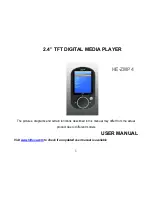
RQT9243 or RQT9350
46
Glossary
AVCHD
AVCHD is a new format (standard) for high definition video cameras
that can be used to record and play high-resolution HD images.
BD-J
Some BD-Video discs contain Java applications, and these
applications are called BD-J. You can enjoy various interactive
features in addition to playing normal video.
BD-Live
This is a BD-Video (BD-ROM version 2 Profile 2) that supports the
new functions such as Internet connection, etc. in addition to the
BONUSVIEW function.
Bitstream
This is the digital form of multi-channel audio data (e.g., 5.1 channel)
before it is decoded into its various channels.
BONUSVIEW (Final Standard Profile)
This is a BD-Video (BD-ROM version 2 Profile 1 version 1.1) that
supports the new functions such as Picture-in-picture, Secondary
Audio, and Virtual Package, etc.
Deep Color
Deep Color is a name for device that can reproduce greater color
gradation (4096 steps) when connected to a TV that supports the
deep color with HDMI cable. You can enjoy exceptionally rich,
natural-looking colors, with smooth, detailed gradation and minimal
color banding. [A lower color gradation (256 steps), without deep
color, will be reproduced if connected to a TV which does not support
deep color. The unit will automatically set appropriate output to suit
the connected TV.]
DivX
[BD55]
DivX is a popular media technology created by DivX, Inc. DivX media
files contain highly compressed video with high visual quality that
maintains a relatively small file size.
DNS Server
A server which acts like a telephone directory and translates Internet
domain names into IP addresses.
Dolby Digital
This is a method of coding digital signals developed by Dolby
Laboratories. Apart from stereo (2-channel) audio, these signals can
also be multi-channel audio.
Dolby Digital Plus
Multi-channel audio and higher audio quality is made possible using
Dolby Digital Plus. BD-Video supports up to 7.1 channel output.
Dolby TrueHD
Dolby TrueHD is a very high quality audio format that reproduces the
studio master audio. BD-Video supports up to 7.1 channel output.
Down-mixing
This is the process of remixing the multi-channel audio found on
some discs into fewer channels.
DTS (Digital Theater Systems)
This surround system is used in many movie theaters. There is good
separation between the channels, so realistic sound effects are
possible.
DTS-HD
DTS-HD is a high-quality, sophisticated audio format used in movie
theaters. Previous DTS Digital Surround-compatible equipment can
play DTS-HD as DTS Digital Surround audio. BD-Video supports up
to 7.1 channel output.
DTS-HD High Resolution Audio
This is a signal format achieved by improving the previous DTS,
DTS-ES and DTS96/24 formats. It is compatible with sampling
frequency 96 kHz/48 kHz. BD-Video supports up to 7.1 channel
output.
DTS-HD Master Audio
This is a lossless audio format and compatible with 96 kHz/7.1ch or
less. In addition, faithful reproduction of the master audio is enabled
using lossless audio encoding technology. BD-Video supports up to
7.1 channel output.
Dynamic range
Dynamic range is the difference between the lowest level of sound
that can be heard above the noise of the equipment and the highest
level of sound before distortion occurs.
Dynamic range compression means reducing the gap between the
loudest and softest sounds. This means you can listen at low
volumes but still hear dialog clearly.
Film and video
DVD-Video are recorded using either film or video. This unit can
determine which type has been used, then uses the most suitable
method of progressive output.
Film:
Recorded at 24 frames per second. (Recorded at 30
frames per second as well). Generally appropriate for
motion picture films.
Video:
Recorded at 30 frames/60 fields per second. Generally
appropriate for TV drama programs or animation.
Frames and fields
Frames refer to the single images that constitute the video you see on
your television. Each frame consists of two fields.
≥
A frame still shows two fields, so there may be some blurring, but
picture quality is generally better.
≥
A field still shows less picture information so it may be rougher, but
there is no blurring.
Gateway
IP address of the electronic device providing Internet access.
Usually called a router IP address. (e.g., 192.168.0.1)
HDMI (High-Definition Multimedia Interface)
HDMI is a digital interface for consumer electronic products. Unlike
conventional connections, it transmits uncompressed digital video
and audio signals on a single cable.
Hub
Used for connecting more than one device to the network.
IP address
A set of numbers which distinguish each device on the network when,
for example, connected to the Internet. When using a PC in a LAN to
access a PC or device that is not included in the LAN, the IP address
is called the local IP address. (e.g., 192.168.0.10)
JPEG (Joint Photographic Experts Group)
This is a system used for compressing/decoding color still pictures. If
you select JPEG as the storage system on digital cameras, etc., the
data will be compressed to 1/10–1/100 of its original size. The benefit
of JPEG is less deterioration in picture quality considering the degree
of compression.
LAN (Local Area Network)
A group of linked devices in a company, school or home.
Indicates the boundaries of a particular network.
Local storage
This storage area is used as a destination for sub contents for playing
virtual packages on BD-Video.
LPCM (Linear PCM)
These are a kind of PCM format.
These are uncompressed digital signals, similar to those found on
CDs.
MP3 (MPEG Audio Layer 3)
An audio compression method that compresses audio to
approximately one tenth of its size without any significant loss of
audio quality.
Frame
Field
Field
u
r
DMP-BD55_35PP-RQT9243_ENG.book 46 ページ 2008年8月29日 金曜日 午前10時28分



































